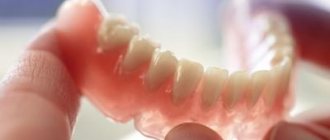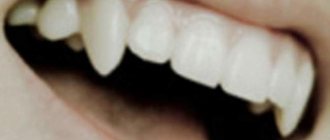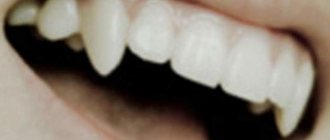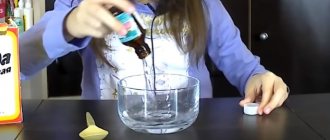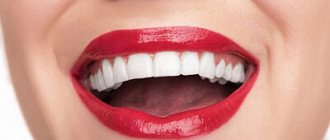There are these types of dentures:
- removable structures with fixation;
- clasp;
- partial or temporary;
- flexible;
- silver or titanium inlays;
- various types of crowns - zirconium oxide, cast metal, metal-ceramic;
- veneers;
- dental implants.
The final price depends on the type of prosthesis, materials, and complexity of the work. The wide range of possibilities in dentistry allows patients, in consultation with their attending physician, to choose effective solutions.
Why do crowns fall out?
This may be due to:
- Loss of cement elasticity, causing the crown to become uncemented.
- Damage to the prosthesis due to heavy loads when chewing or biting off hard food.
- By installing temporary cement that has not been removed.
- The beginning of the appearance of caries at the edges of the tooth.
- Frequent consumption of viscous foods - toffees, chewing sweets.
- Installing the product on a small tooth.
Whatever the reasons for the loss, this defect will not be attractive. And correctly selected glue will eliminate the disadvantage.
There are professional compounds for attaching single crowns and bridges. They securely fix crowns, but are sold only in specialized stores and are very expensive (from 5 thousand rubles and above). There are also simpler options that can be found at a regular pharmacy.
Here are a few of the most affordable ones:
- Polyacrylin from (Belgorod region) is a two-component dental adhesive for crowns based on finely dispersed special glass, polyacrylic and tartaric acid. Suitable for permanent fixation of metal and non-metal dental crowns, bridges, as well as for quick attachment of inlays and pins. Polyacrylin has high adhesion, an anti-caries effect, good biological compatibility, and ensures absolute reliability of fixation. The composition of the two-component adhesive includes powder 10 g + liquid 8 g. The powder is fluoride glass, the liquid hardener is polyacrylic acid. When the components are mixed, a plastic composition is formed, which hardens into durable cement. Packaging costs about 700-800 rubles.
- Cemion-F (VladMiva, Belgorod) is a set of three components for fixing crowns and other orthodontic structures. The kit includes: powder 20 g, liquid hardener 15 ml, conditioner 10 ml. The adhesive composition, obtained by mixing powder and hardener, has high adhesion to enamel, increased mechanical strength and low solubility. Provides reliable sealing of the adhesive joint, releases fluoride for a long time, which strengthens the hard tissues of the stump and prevents the development of secondary caries. This inexpensive compound can be used as a temporary adhesive for crowns. The cost of the set is 450-500 rubles.
- GLASSIN Fix (“Omega Dent”, Moscow) is a two-component dental dental adhesive (powder + solution system). The powder is the smallest particles of fluorosilicon glass, the liquid is a hardener based on an aqueous solution of polyacrylic acid. GLASSIN Fix has high adhesion to dental tissue and good biological compatibility. Due to the prolonged release of fluoride ions, an anti-caries effect is ensured. The set is sold in pharmacies and costs about 600 rubles.
Stages of making dentures at home
In laboratory conditions, the manufacturing process of any model takes place in several stages:
- treatment of oral diseases;
- taking an impression to make an impression tray;
- casting the base and trying it on the patient;
- splinting or reinforcing the structure;
- additional fitting to adjust crowns, select shade and material for teeth;
- final grinding and fitting of dentures , strengthening of crowns and gum ridges;
- issuing the product to the patient, correction if necessary.
Depending on the materials chosen, the dental technician’s work takes from 3 days to 1 month.
Purchasing material
To make or repair a denture with your own hands , you need to purchase several materials:
- pharmaceutical glue;
- monomers for diluting acrylic mass;
- various brushes and sanding accessories;
- clay or impression composition;
- base wax;
- sealants.
It is better to make a purchase in a specialized store. An experienced consultant will help you select high-quality and safe formulations and advise on the principle of action and polymerization. It is necessary to make sure that there are certificates confirming hypoallergenicity.
Preparing the matrix and impression
make matrices on a denture with your own hands using beeswax, special clay or plaster. The composition is diluted to maximum density so that it retains its shape. The requirements for it are minimal:
- absence of unpleasant odors and taste;
- ability to retain shape when stored indoors;
- easy detachment during modeling;
- ability to withstand temperature changes.
To make a high-quality impression, the required amount of mass is placed on a special spoon. It is carefully inserted into the oral cavity, after which the person slowly closes his jaws. After unclamping, an exact model with the smallest defects and indentations remains on the plaster or wax. In modern conditions, alginate mixtures are more often used.
Preparing the mass for pouring into the mold
After hardening, the impression can be used for further production of a denture with your own hands . The next step is to form a base from acrylic dough. Its preparation is not difficult:
- pour the powder into a glass or plastic container;
- add monomer in a ratio of 1 to 3;
- stir gently and quickly to break up any lumps;
- leave for 30–40 minutes until ripe.
Read Temporary dentures - for one tooth, for the lower and upper jaw, prices and reviews
In order not to violate the technology and prepare the solution for dentures correctly, it is better to use scales, strictly observe the proportions and maintain the time interval.
Casting and fitting
The most difficult stage in the procedure for making dentures is casting the base and gum ridges. The quality of work depends on the reliability and durability of the future design. When the acrylic mass acquires the structure of an elastic dough, it is kneaded on the matrix, trying to make an even and uniform layer. After molding, it is advisable to dry it at a temperature of 50–80°C in the oven.
Dentists call fitting the final stage of work on a denture product. It consists of assembling all the parts and pieces, welding metal fasteners and clasps. Using medical glue, it is necessary to imprint the crowns or secure the veneers. Additional grinding should achieve natural curves and remove roughness and unevenness on the gums. Trying on the patient helps to adjust the prosthesis so that when worn, it is as comfortable as possible for the person to chew and speak.
Methods of fixing removable dentures
With the fixation of dentures that can be removed, the situation is more complicated. Particular difficulties can arise with the attachment of partial and complete acrylic or nylon dentures.
Fixation of full-type removable dentures (when teeth are missing) occurs due to the suction effect that occurs in the oral cavity.
Clasp-type dentures are attached using attachments (locks) or clasps (metal hooks).
In order to securely fasten such structures in the mouth, a whole range of measures are used: the partial denture is attached using metal or acrylic hooks, resting on the remaining teeth; the alveolar processes serve as an additional place of fixation. When you put on a removable denture, a suction effect occurs, which also contributes to good fixation.
If your oral cavity remained motionless, then the measures listed would be quite sufficient. However, when you eat food, when you chew, or sneeze, yawn, if you have active facial expressions, then as a result of this, the hooks are displaced, air gets under the prosthesis, which in the future can lead to its displacement or even falling out.
To grow a tooth or strengthen the enamel?
All advice on how to grow teeth at home only concerns strengthening tooth enamel. It is really possible to build up, or rather strengthen, tooth enamel at home. With age it becomes thinner; various metabolic disorders in the body, lack of calcium and fluoride make it loose, which is why the tooth is easily attacked by bacteria. To avoid problems, you need to take vitamin complexes, review your diet, and use special toothpastes and mouthwashes.
Under no circumstances should you prescribe all this to yourself. Be sure to consult your dentist! The clinic will offer you a remineralization procedure, the purpose of which is to strengthen the enamel. This will help keep your teeth healthy, but you won’t be able to build them up this way.
In what cases can a fallen crown be put back?
Re-fixation of a permanent crown is possible if the following conditions are simultaneously present:
- if the supporting tooth is intact, has no chips or cracks,
- there is no need to treat/grind the tooth,
- if the prosthesis is not damaged or only slightly damaged: a small chip of ceramic on the metal “cap” can be restored.
It is also possible to reinstall a fallen temporary plastic or composite prosthesis. But all of the above conditions must also be met.
“A month and a half ago, I began to notice that the dental crown was moving out or seemed to be tilting. There was still no time to get to the doctor, and somehow I didn’t attach much importance. And while celebrating my sister’s birthday, I felt like I was chewing something wrong in my mouth. It turned out that the crown fell off while eating! I put it on a napkin and in my pocket. And the next day I went to the dentist. He examined everything, took an x-ray and said that we can glue it back and walk like this for a year or two.”
Alexander, review from the site irecommend.ru
Is it possible to grow a tooth yourself?
Do human teeth grow? Yes, of course, they grow, because children no longer have “adult” teeth erupting. By this logic, it is quite possible to grow a tooth on yourself. But it was not there! Let's turn to the facts that the science of biology provides us.
In humans, tooth growth stops at 15-17 years of age. This process is genetically determined. Every person's teeth contain stem cells from which teeth could be re-grown. However, for reasons unknown to science, these cells “sleep”. Unlike sharks, camels, mice, beavers and other animals, whose teeth regenerate (grow) throughout their lives.
Only in 2022, biologists discovered the DLK1 protein in mice, which activates dental stem cells. Perhaps further study of it will answer the question: “Is it possible to regrow teeth?” So far, it is impossible to even “revive” a tooth again after removing the pulp (nerve), and science has not even begun to grow it again.
Causes of tooth crown loss
Before looking for ways to glue a temporary prosthesis, let’s figure out why it fell out. There may be several reasons for this:
- hard and sticky foods (chewing candies, nuts);
- the end of the service life of the cement on which the crown was previously glued;
- habit of chewing hard objects (pens, pencils);
- formation of deposits on the edges of the crown;
- low teeth that do not allow the crown to attach well. (Specialists eliminate this drawback by using special resins in their work).
Is it possible to put a filling at home?
Anyone can experience an old filling falling out. In this case, the tooth is restored only in a dental office. True, there are thrifty craftsmen who post videos on the Internet about growing a tooth at home, or rather, about replacing a filling yourself. For this purpose, dental cement and food grade phosphoric acid are used.
However, in this way you also preserve the infection, which clearly developed under the old filling. Bacteria will continue to destroy the tooth from the inside. The only solution is to go to the dentist, where the remaining filling material will be removed, the cavity in the tooth and the root canals will be cleaned. And then the tooth will be filled again.
Similar advice is found for cases when a poorly installed crown falls out. “Experts” seriously discuss how to glue an extended tooth at home. The result of doing it on your own will be the same - an infection will develop under the crown glued at home, and within a couple of months the tooth will begin to decay.
Feeling discomfort from the prosthesis
It is also possible to feel discomfort in the mouth after installing a denture:
- Problems with pronunciation.
- Increased salivation.
- A feeling of something foreign in the mouth.
- Rubbing of the gums and the inside of the cheek.
Usually these phenomena go away after 10–15 days, but if the discomfort persists for a long time, you should go to a specialist for a more precise fit of the prosthetic structure and eliminate problems with dental prosthetics.
Reinforcement of partially lost teeth
As you already understand, the problem of how to regrow teeth cannot be solved at home; only a dentist can do this.
- Extension with composites. A tooth that is no more than half destroyed is restored with composite materials - light-curing fillings. The doctor applies the composite layer by layer, treating each of them with an ultraviolet lamp. Finally, the surface is sanded and polished.
- Extension with tabs. A more durable, high-quality and aesthetic alternative to composite fillings is ceramic inlays. They completely replicate the lost part of the tooth, and are manufactured using high-precision CAD/CAM equipment. Dental cement is used for installation.
- Extension with crowns. If the tooth is significantly damaged, it is depulped (the nerve is removed), ground down, and a crown is attached to it like a cap using dental cement. It can be made of metal ceramics, ceramics or zirconium dioxide. In cases where only the root remains of the tooth, it is possible to install a crown on a pin.
- Extension with veneers. If cracks, chips have formed on the surface of the front teeth, or simply their shape does not suit the patient, teeth can be augmented with thin (up to 1 millimeter) ceramic plates. They are glued to the outside of the teeth after pre-treatment. The result is a Hollywood smile with perfect teeth.
Contraindications
Before self-treatment, it is recommended to make sure that the source of pain is the tooth, and not the soft tissues of the oral cavity or neoplasms. The latter means:
- abscess;
- cysts;
- tumor formations;
- granulomas, etc.
If the dental nerve (pulp) is inflamed and there is intense pain, it is prohibited to close the hole with a filling. Absolute contraindications to the procedure are dental and systemic diseases.
Installation of filling material is allowed if there is mild pain and a deep cavity without darkening. The initial stages of caries are regarded as a contraindication, along with advanced carious processes. Otherwise, under a permanent filling, the disease develops faster, affecting dental tissue, dentin, and nerves.
If intense pain occurs, it is recommended to apply hygienic paste with fluoride to the chewing surface of the tooth before the procedure. Its composition has a calming effect and fills microcracks. It is prohibited to instill alcohol solutions into a carious cavity. The drug causes destruction of the nerve and soft tissues, provokes decomposition and necrosis.
If the hole is small, the filling must be placed by a doctor. It is impossible to fill the hole completely on your own. This allows food particles to become trapped and bacteria to grow in the open cavity.
Installation of a permanent filling
If you decide to put a filling yourself, then you can use the Acrodent tooth filling material. The set includes 3 tubes and 2 bottles of cleaner. It should be remembered that if a tooth hurts, you cannot work on it without first cleaning it. In addition to Acrodent, you will need:
- hair dryer;
- dental spatulas (they are often included with the material, but can be purchased separately);
- cotton swabs.
Making a filling
- We brush our teeth in the same way as in the first case.
- Mix the components of the kit as written in the instructions. You should get an elastic mixture that resembles dough. You need to work with it quickly enough: after 5 minutes it will polymerize and harden like stone.
- Using a spatula, seal the bottom of the hole. To make the mixture more dense, tamp it with your finger.
- Use a hairdryer to dry the filling. We wipe away any drool with cotton swabs.
- We repeat the procedure with applying the material. Now you need to walk around with your mouth open for 10 minutes. During this time, the unpleasant odor of the acid contained in the solvent will completely disappear.
- After just 10 minutes, the filling will harden, but the hardening process will continue for up to 6 hours. During this period you will have to refrain from eating food.
- The filling is ready. If this tooth starts to hurt in a couple of weeks or months, a visit to the dentist is inevitable. Otherwise, you can pay at least a tooth.
Tsivinsky method
The Tsivinsky method is the fastest and most affordable way to place a temporary (therapeutic) filling in a damaged tooth. It involves the use of the patented Santedex powder, which is freely available for sale in pharmacies. To seal a tooth with the mixture:
- Prepare the solution according to the instructions. The product is mixed with a small amount of liquid from the kit to form clay.
- Clean the oral cavity and the filling area. The teeth are cleaned with hygienic paste, and the carious canal is additionally treated. To prevent saliva from entering and increase the strength of the filling, Vaseline or vegetable oil is applied to the installation site.
Within 30 minutes, the paste will be absorbed into the tissue and distributed along the carious canal. It is more convenient to place a filling before going to bed so that the powder performs its healing function overnight. In the morning, the material is removed and a permanent filling is placed in the hole.
The procedure can be repeated several times if pain reappears. User reviews show that temporary fillings using the Tsivinsky method help to significantly improve the condition of teeth recommended for removal. More details about the effectiveness of the drug are described in specialized literature.
According to the creator, Santedex powder can be used for any degree of tooth decay. The product provides a double effect:
- relieves inflammation;
- disinfects the area.
After removing the temporary filling, the cavity must be immediately filled with a permanent one if there is no pain. Painful sensations accompany inflammation of the nerve (pulpitis) and require treatment of the disease in a dental clinic.
Precautionary measures
Unfortunately, the manufacturers of these products cannot guarantee a successful result. After all, the lion's share of success lies in correct dental diagnosis. By filling an insufficiently cleaned tooth, you create a place in its middle for various infections that multiply very quickly. An inflamed nerve cannot be saved in this way either. Therefore, it is best to monitor your dental health and have regular dental examinations. Then there will be no neglected problems and exorbitant expenses.
What are the disadvantages of veneers that need to be taken into account?
The main disadvantage is that they cannot be removed by yourself or even dismantled without damaging them. These are not braces. Well, the enamel needs to be prepared - yes, in a thin layer, only 0.5-0.7 mm, but even such an impact can bring negative consequences. Protection against pathogens, aggressive environments, mechanical and chemical factors deteriorates.
As a result, you cannot simply remove the plates - after this you need to either attach new ones or use some other method of restoring the beauty of your smile.
Existing pathologies should also be taken into account. In severe cases, microprostheses can provoke a change in diction. Another disadvantage of veneers lies in the fact that the teeth protruding from under them will still be stained and darken, which means that over time they will become different in color, at least on the inside. To prevent this aesthetic problem, you need to change your menu and stop smoking. Although giving up bad habits is, in principle, a sound idea, even if everything is fine with a smile.
These overlays must be fixed by a specialist, because in case of non-compliance with the technology or errors, the following unpleasant consequences are possible:
- Loose fit and, as a result, darkening of the plate.
- Protruding edges that can cause injury to the soft tissues of the oral cavity.
- A manifestation of hypersensitivity, indicating either poor enamel cleaning or the development of caries.
In addition, you can break off a piece of such a microprosthesis if you thoughtlessly bite into too hard food.
Filling teeth at home: benefits
In the absence of pain and carious lesions, you can fill a tooth at home without going to the doctor. Self-installation of a filling helps:
- Reduce waste of time and money. A “homemade” filling is much cheaper than one placed by a doctor in a clinic. The procedure takes no more than an hour and does not require changing your usual schedule.
- Save the damaged tooth. There are dentists who still prefer radical methods to modern treatment. By filling the hole yourself, you can avoid removal and subsequent costs for prosthetics.
- Prevent infection. Regardless of the level of the clinic, there is no complete confidence in the quality and compliance with instrument processing techniques. The devices used at home are absolutely sterile.
- Avoid stress. The need to visit a dentist simply frightens most adults. The home filling method helps eliminate the problem without discomfort.
Teeth are filled at home if there are no contraindications to the procedure. If it is possible to obtain advice from a competent specialist, it is advisable to use the services of a professional dentist.
